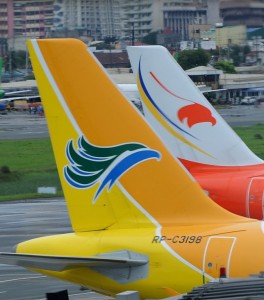
This photo taken on July 21, 2012, shows Philippines budget carrier Cebu Pacific (left) and Airphil Express jets parked at Manila international airport. The number of passengers on Philippine domestic flights continued to grow in the first half of the year as local airlines continued to pursue aggressive expansion that brought down ticket costs. AFP PHOTO / TED ALJIBE
The number of passengers on domestic flights continued to grow in the first half of the year as local airlines continued to pursue aggressive expansion that brought down ticket costs.
Data from the Civil Aeronautics Board (CAB) showed that total domestic air passenger traffic grew 13.33 percent year on year to 11.017 million in the January-June period of 2012.
The country’s airlines offered a total of 14.64 million seats during the six-month period, up from 12.12 million last year. This gave the industry an average load factor of 75 percent, which means one in four seats on every flight was vacant.
Load factor refers to the percentage of seats filled in every flight relative to the number of seats on a plane.
The Gokongwei-led budget carrier Cebu Pacific remained the market leader, accounting for a total of 4.99 million people in the first half, up 17 percent over last year. The growth in passengers, however, could not keep up with the expansion in the company’s capacity.
Cebu Pacific added 25 percent more seats in the first half of 2012 to a total of 6.37 million. As a result, the company’s load factor fell from 84 percent to 78 percent.
Earlier this month, Cebu Pacific said, its average ticket prices fell 3.7 percent to P2,257 per person due to stiff competition among airlines.
Flag carrier Philippine Airlines (PAL), meanwhile, continued to lose market share as its passenger count fell 3.8 percent to 2.29 million in the six-month period. The company also reduced its number of seats to 3.046 million from 3.101 million. Load factors were also down 2 percentage points to 75 percent.
The decline in PAL’s numbers, however, was more than offset by the growth of passengers served by its sister firm, Air Philippines.
Operating as Airphil Express, the PAL unit reported a 29-percent surge in domestic passengers to 2.39 million as seats increased by 36 percent to 3.286 million.
Southeast Asian Airlines (SEAir), which recently shifted its focus to international operations, posted a steep decline in domestic passengers to 17,565 in the first half from 97,326 last year.
Zest Airways, owned by juice drink magnate Alfred Yao, had 1.26 million domestic passengers in the period, up slightly from 1.14 million last year.
Meanwhile, AirAsia Inc., the local unit of Malaysia’s AirAsia Berhad, had 60,381 passengers in the first half. AirAsia started operating in the Philippines last March. The company, which operates out of Clark Freeport, had the industry’s worst load factor at 45 percent.